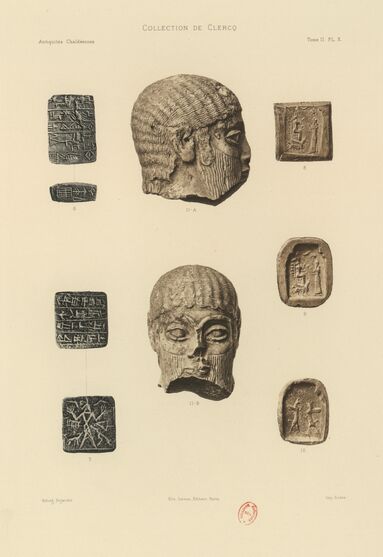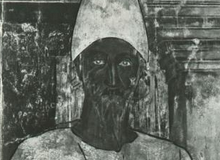It was during the period of the French Mandate that the great archaeological missions were launched in the Near East (Syria-Lebanon) and that the excavation service was organised. René Dussaud was the linchpin and main organiser, while Henri Seyrig took charge of the reorganisation of the Service of Antiquities, then the direction of the French Institute of Damascus.
French archaeology in Syria developed as of the mid 19th century, succeeding in this way to a period which saw travellers making drawings of the vestiges of the past. The most famous of these French draughtsmen, whose drawings remains extremely useful, even if they are essentially the reflection of personal interpretations, was Louis-François Cassas (1756-1827). Even under the Ottoman empire, in other words until the First World War, the research being carried out was more a question of “scientific travels”. In this respect, we could cite the work of Ernest Renan (1823-1892) who, in October 1860, was charged by Napoleon III to carry out archaeological and epigraphical research in Palestine and Syria, the results of which were published under the title Mission de Phénicie (Paris, 1874); four regions were studied: the regions of Arwad-Arados and Amrit-Marathos (modern Syria), and those of Byblos, Sidon and Tyr (modern Lebanon). The same vein illustrates the activities of a diplomate, the Marquis Charles-Jean Melchior de Vogüe (1829-1916), who, during his travels in the region, particularly focused on the study of Semitic languages, as well as Syrie centrale, architecture civile et religieuse du Ier au VIIe siècle (Paris, 1865-1877). This work is still used as a basis, thanks to the plates made by the draughtsman and architect E. Duthois, to all the later work done in the Limestone Massif to the North, as well as the basaltic region of Hauran, to the south of Syria.
But it was above all during the period of the French Mandate (1920-1946) that the great archaeological missions in the Near East (Syria-Lebanon) were launched and the excavation service was organised. René Dussaud (1868-1958) was the linchpin and main organiser. He provided French archaeology with two essential instruments, the review Syria, the official outlet of the Service of Antiquities for the diffusion of French projects, and the Bibliothèque Historique et Archéologique (BAH), aimed at promulgating archaeological research and syntheses. His two major personal works derived in one case from his journeys and prospections, with Topographie historique de la Syrie antique et médiévale (Paris, 1927), and in the other from an in-depth reflexion about the movements of the Arabs, to be republished later in La pénétration des Arabes en Syrie avant l’Islam (Paris, 1955). For twenty years, the archaeological missions were under his ultimate authority: he supported the resumption of the work in Lebanon, in Sidon and Byblos, and in Syria he launched the digs in Ras Shamra-Ugarit under the direction of Claude Schaeffer, and in Tell Hariri-Mari under the direction of André Parrot.
R. Dussaud’s role was considerable thanks to his research, work and experience in the field, but also thanks to his choice of the men who would be in charge of applying his reforms. So it was that he confided to Henri Seyrig, in 1929, the reorganisation of the Service of Antiquities, and, in 1938, the direction of the French Institute in Damascus.
Henri Seyrig (1895-1973) deeply marked archaeological research for a good fifty years and was at the origin of its development, which is still being pursued in the 21st century, long after his death. In 1929, he was appointed director of the Service of Antiquities (until 1941), then, from 1946 to 1967, director of the new French Archaeological Institute of Beirut. He spent almost forty years in the Near East. As well as supporting French archaeological missions, he favoured the establishment of foreign missions: in Antioch, the mission of Princeton University, in Dura-Europos, that of Yale University, in Apamea, the Belgian mission of the Royal Museums of Art and History in Brussels, at Tell Halaf, a German mission, and at Hama, the Danish mission of the Ny Carlsberg Foundation.
His personal activity was focused on the rehabilitation of three main sites: Krak des Chevaliers, Baalbek (Lebanon), and Palmyra. In the latter site, he evacuated the Arab town established in the sanctuary of Bel, and had it rebuilt in next to the oasis (the “new village”). He kept up an intense activity as a researcher, most of his articles being published in the review Syria, later to be collected in the seven volumes of Antiquités syriennes (over a hundred pieces, some of which are still essential reading), to which should be added Scripta varia (1985). In Palmyra, he set about emptying out the sanctuary of Bel and excavating the temple (with the architect Robert Amy), the exploration of the agora and of the large habitation at the back of the sanctuary of Bel (with the architect Raymond Duru), the excavation of the tomb of Yarhai in the West Necropolis and its transfer to the Museum of Damascus (with the architect R. Amy). His publications dealt with various fields, including a large number devoted to numismatics, published in his Scripta Numismatica (1986). He chose his inspectors well, such as Maurice Dunand (1898-1987) and Daniel Schlumberger (1904-1972).
M. Dunand worked with François Thureau-Dangin at Arslan Tash in 1928, where an important batch of Assyrian ivory was discovered, and at Tell Ahmar, from 1929 to 1931. But his main activity was the excavation of Byblos, for which he benefited from the assistance of the architect-archaeologist Jean Lauffray.
D. Schlumberger succeeded H. Seyrig when he retired. The name of Claude Schaeffer (1898-1982) cannot be dissociated from the excavation and study of the site of Ras Shamra-Ugarit, which he began to explore in 1929. This work was interrupted by the Second World War, before being resumed in 1948 under his direction, until 1969.
The other main, long-term French mission was at Tell Hariri-Mari, directed by André Parrot (1901-1980) from 1933 to 1974, with an interruption during the Second World War.
For the archaeology of the Muslim period, we should mention the name of Jean Sauvaget (1901-1950) who focused his main research on the towns of Damascus, Aleppo and Latakia, concerning their urban and topographical evolution, their various monuments, and Arabic inscriptions.
After the independence of Syria in 1946, it became the DGAM’s role to pick up the archaeological research whose bases had been laid under the French Mandate.





.png)